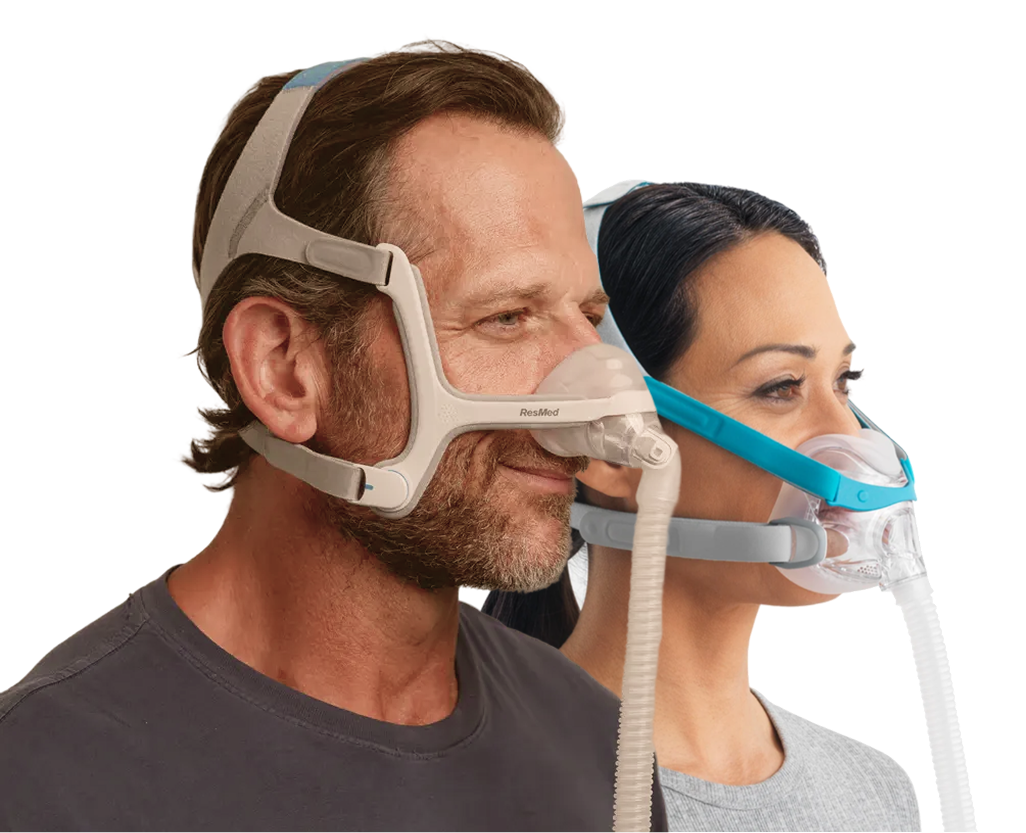BiPAP vs CPAP are both positive airway pressure (PAP) therapies used to treat sleep apnoea. The main difference is how they deliver air pressure CPAP provides a constant pressure, while BiPAP offers two adjustable pressure levels for inhaling and exhaling. Choosing the right option depends on your breathing needs and comfort. For expert advice and competitive pricing on trusted sleep therapy equipment, visit CPAP Discount Warehouse today.
What is BiPAP vs CPAP?
CPAP stands for Continuous Positive Airway Pressure and is a system that delivers a constant flow of air through a mask via the nose or mouth, helping to keep the airways open and preventing breathing from stopping, similar to gentle pressure on the airways to keep them clear. It is primarily designed to treat obstructive sleep apnea, a condition where the upper airway repeatedly becomes blocked.
Similarly, BiPAP stands for “Bilateral Positive Airway Pressure” and refers to a airway pressure system that provides two levels of pressure. The pressure is higher during inhalation and lower during exhalation. BiPAP allows people who need extra support when exhaling to breathe more easily and naturally. This flexibility makes it appropriate for a broader range of individuals, including those with obstructive sleep apnea, central sleep apnea, chronic obstructive pulmonary disease (COPD), and heart failure.

What is the difference between CPAP and BiPAP?
CPAP delivers a steady stream of pressurised air to keep the airway open throughout the entire breathing cycle. It is widely used to manage obstructive sleep apnoea and reduce snoring.
BiPAP provides two levels of air pressure higher during inhalation and lower during exhalation making it easier for people who find constant pressure difficult to tolerate. BiPAP is particularly beneficial for individuals with conditions such as obesity hypoventilation syndrome or neuromuscular disorders.
|
Feature |
CPAP |
BiPAP |
|
Pressure levels |
Constant or single level |
Variable or two levels (higher for inhale, lower for exhale) |
|
Indication |
Obstructive sleep apnea and snoring |
Sleep apnea with difficulty exhaling and neuromuscular disorders |
|
Breathing Pattern |
Continuous
|
Bilevel (inhale and exhale)
|
|
Patient comfort |
May be uncomfortable for some due to fixed pressure |
Can be more comfortable, especially for exhaling difficulty |
|
Range of Pressure |
4-20 cm H20 |
4-30 cm H20 |
|
Cost |
$500 – $1,000 |
$1,700 – $3,000 |
What are the Benefits of CPAP?
Although both CPAP and BiPAP are proven treatments for sleep apnoea, CPAP is typically recommended as the first-line therapy in Australia. For many people, CPAP provides a straightforward and accessible solution. Key advantages of CPAP over BiPAP include:
+ Ease of use: CPAP machines are simple to operate, with minimal settings to adjust.
+ Cost-effectiveness: CPAP machine are generally more affordable than BiPAP machines, both in initial purchase and ongoing maintenance.
+ Greater availability: CPAP therapy is widely prescribed and easily accessed through Australian sleep clinics, pharmacies, and private health insurance providers.
+ Effective for most cases: CPAP is usually sufficient to manage mild to moderate obstructive sleep apnoea without the need for varying pressure levels.
What are the Benefits of BiPAP?
BiPAP is designed to support people with sleep apnoea who have difficulty breathing under constant pressure. By delivering higher pressure during inhalation and lower pressure during exhalation, BiPAP promotes easier breathing and more restful sleep.
+ Adjustable pressure levels: BiPAP machine provides customised pressure settings, offering greater comfort for individuals who struggle with a single, constant pressure.
+ Support for complex conditions: BiPAP is particularly beneficial for people with conditions such as obesity hypoventilation syndrome or neuromuscular disorders, where additional breathing assistance is required.
+ Enhanced comfort and sleep quality: By matching natural breathing patterns, BiPAP can improve airflow, reduce effort during breathing, and support deeper, more restorative sleep.

>>>> APAP vs CPAP: Key Differences & Benefits for Sleep Apnea
When to use CPAP vs BiPAP?
As noted, CPAP remains the gold standard treatment for obstructive sleep apnea. It is highly effective in reducing apneas and hypopneas, resulting in substantial improvements in overall quality of life.
- BiPAP, on the other hand, is utilized in various clinical settings:
- Central Sleep Apnea: The dual-pressure system helps stimulate breathing and prevent central apneas.
- COPD: BiPAP has been shown to alleviate dyspnea, decrease hospital admissions, and improve the quality of life for patients with COPD.
- Heart Failure: BiPAP can reduce shortness of breath and enhance oxygenation in individuals with acute or chronic heart failure.
BiPAP vs CPAP: Which Is Best for You?
The choice BiPAP vs CPAP is influenced by several key factors, including:
- Type of Sleep Apnea: Whether the condition is obstructive, central, or mixed.
- Severity of Symptoms: The frequency and duration of apneas, as well as the level of daytime sleepiness.
- Presence of Other Respiratory Conditions: Such as COPD or heart failure.
- Patient Tolerance: Comfort level with the mask and the therapy itself.
A comprehensive evaluation by a respiratory specialist, including a detailed sleep study, is crucial in determining the most suitable therapy for each individual patient.

>>>> Overiew Apnea Definition & Meaning - CPAP Discount
Conclusion
BiPAP vs CPAP play an essential role in the treatment of sleep apnea and other respiratory conditions. While CPAP is simpler and more commonly utilized, BiPAP provides greater adaptability and is particularly advantageous for patients with more complex medical needs. The selection of the most appropriate therapy should be tailored to each patient’s individual requirements and clinical circumstances. As a respiratory specialist in Australia, CPAP Discount Warehouse advocate for a personalized approach to care to achieve the best possible outcomes for every patient.






